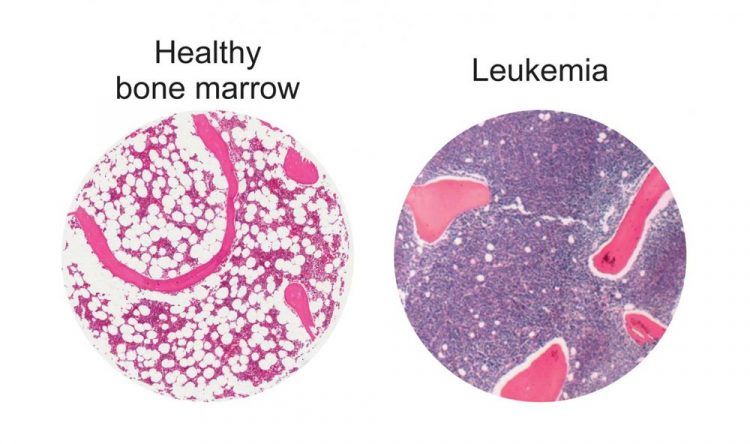Bolstering fat cells offers potential new leukemia treatment

These are fat cells (white circles) in healthy human bone marrow, left, compared to bone marrow in a patient with leukemia, right. Image courtesy McMaster University
Researchers with the McMaster Stem Cell and Cancer Research Institute found that boosting adipocytes, or fat cells, located in the bone morrow suppressed cancerous leukemia cells but – in a surprise to the research team — induced the regeneration of healthy blood cells at the same time.
The production of healthy red blood cells is critical for those with acute myeloid leukemia but is sometimes overlooked as conventional treatments focus on killing the leukemia cells alone. Patients with this disease suffer from anemia and infection due to the failure of healthy blood production, all of which are leading causes of hospitalization and death from the disease.
The study was published today in the journal Nature Cell Biology.
“Our approach represents a different way of looking at leukemia and considers the entire bone marrow as an ecosystem, rather than the traditional approach of studying and trying to directly kill the diseased cells themselves,” said Allison Boyd, postdoctoral fellow with the research institute and first author of the study.
“These traditional approaches have not delivered enough new therapeutic options for patients. The standard-of-care for this disease hasn't changed in several decades.”
The McMaster-led study was conducted over the past three and half years and started from observations of leukemia patients. This led to the collection of bone marrow samples from larger cohorts of patients with the Ottawa Hospital Research Institute, as well as those from Western University and Hamilton Health Sciences, for the next steps of investigation. This included detailed study and imaging of individual leukemia cells compared to healthy cells residing in the bone marrow, which revealed the effects of targeting fat cells.
A drug commonly used to moderate diabetes that induces fat cell production in the bone marrow was used and was found to help foster red blood cell production as well as suppress leukemic disease.
“The focus of chemotherapy and existing standard-of-care is on killing cancer cells but instead we took a completely different approach which changes the environment the cancer cells live in,” said Mick Bhatia, director and senior scientist with the McMaster Stem Cell and Cancer Research Institute, who led the group that performed the study.
“This not only suppressed the “bad” cancer cells, but also bolstered the “good” healthy cells allowing them to regenerate in the new drug-induced environment.”
“The fact that we can target one cell type in one tissue using an existing drug makes us excited about the possibilities of testing this in patients.”
“We can envision this becoming a potential new therapeutic approach that can either be added to existing treatments or even replace others in the near future. The fact that this drug activates blood regeneration may provide benefits for those waiting for bone marrow transplants by activating their own healthy cells.”
###
Funding for the study came from the Canadian Cancer Society Research Institute and the Marta and Owen Boris Foundation.
Editors: Pictures of researchers of the McMaster Stem Cell and Cancer Research Institute and illustrations related to this study are available upon request.
For more information, please contact:
Tina Depko
Communications Coordinator
Faculty of Health Sciences
McMaster University
depkot@mcmaster.ca
905-525-9140, ext. 22196
Media Contact
All latest news from the category: Life Sciences and Chemistry
Articles and reports from the Life Sciences and chemistry area deal with applied and basic research into modern biology, chemistry and human medicine.
Valuable information can be found on a range of life sciences fields including bacteriology, biochemistry, bionics, bioinformatics, biophysics, biotechnology, genetics, geobotany, human biology, marine biology, microbiology, molecular biology, cellular biology, zoology, bioinorganic chemistry, microchemistry and environmental chemistry.
Newest articles

First-of-its-kind study uses remote sensing to monitor plastic debris in rivers and lakes
Remote sensing creates a cost-effective solution to monitoring plastic pollution. A first-of-its-kind study from researchers at the University of Minnesota Twin Cities shows how remote sensing can help monitor and…

Laser-based artificial neuron mimics nerve cell functions at lightning speed
With a processing speed a billion times faster than nature, chip-based laser neuron could help advance AI tasks such as pattern recognition and sequence prediction. Researchers have developed a laser-based…

Optimising the processing of plastic waste
Just one look in the yellow bin reveals a colourful jumble of different types of plastic. However, the purer and more uniform plastic waste is, the easier it is to…



